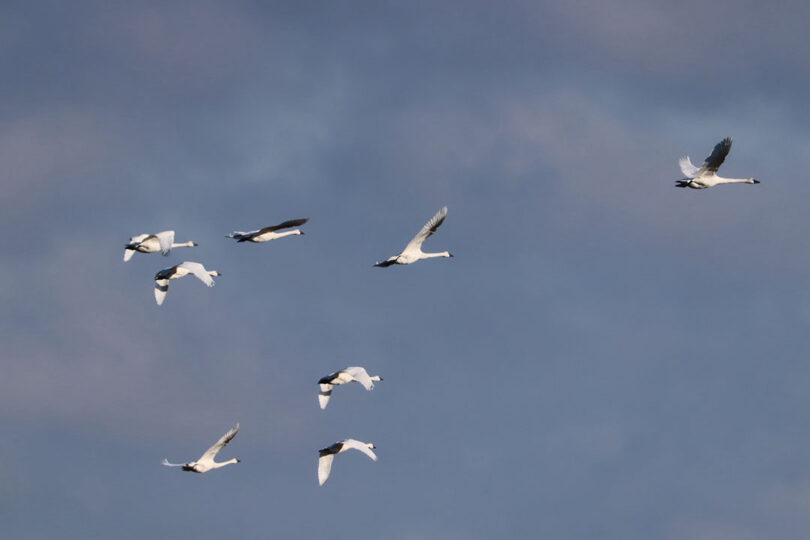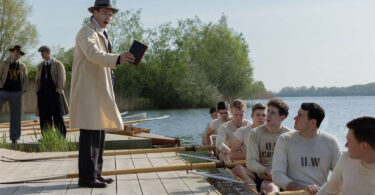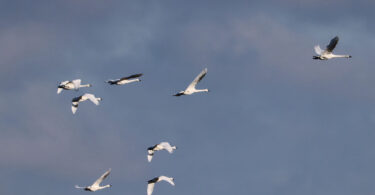Tundra swans in flight above Lake Mattamuskeet. PHOTO BY ALEKSANDRA PRICA
Lake Mattamuskeet’s A Sporting Paradise —Bird Watchers, Hunters, Fishers, Weekenders
First Of Two Parts
Robbie Breitweiser
The term “Inner Banks” was coined by real estate developers and tourism promoters hoping to drum up business in coastal North Carolina, and they’ll apply it pretty loosely if there’s some money in it for them.
To the rest of us, “Inner Banks” are considered the sound-adjacent mainland areas from the Virginia border down to Swansboro or so. These are places shielded from the open ocean by the Outer Banks (assuming, for the sake of argument, that every barrier island from the Bogue Banks to Virginia is the Outer Banks) and, presumably because they lack the waves and views of oceanfront beaches, they don’t draw visitors or revenue like their seaward island neighbors.
There are some beautiful and unique spots in the region, however, and the sparse population and relative quiet of some of them can be rewarding for folks looking to avoid crowds and get out into nature.
Lake Mattamuskeet, a few miles inland from the Pamlico Sound in Hyde County, is a prime example. Despite being the largest natural lake in North Carolina, it remains an obscure destination to most visitors unless they happen to hunt, fish, or enjoy birdwatching. Just a 15-minute drive from where the Swan Quarter ferry departs to Ocracoke, The lake is about 18 miles long by 7 miles wide, but averages only 2 to 3 feet in depth. Lakewaters cover 80 percent of the 50,000 acre Mattamuskeet Wildlife Refuge, home to white-tailed deer, red wolves, black bears, bobcats, river otters and an impressive variety of birds and waterfowl.
Anglers fish year-round from the banks and bridges, and from March through October from boats, catching bass, crappie, sunfish, catfish, perch, bowfin and others. Large blue crabs are said to be plentiful in the lake as well, though by most accounts the crabbing was less productive these past few years due to water quality issues, which I will address later.
Limited deer hunting is allowed on the Refuge; applicants are chosen by lottery for two two-day hunts held in October, where deer may only be taken with a bow, crossbow, shotgun or muzzle-loading rifle. Having no experience with deer hunting and only a bit of youthful experience with dove and duck hunting,
I will not embarrass myself by attempting to discuss hunting here, except to say that I have no moral objection to hunting if it is done in a sportsmanlike manner and the meat is put to good use. Waterfowl hunting is also a big fall and winter activity at the Refuge, with seasons for various birds running from September to February and involving an application and lottery process similar to that used for the deer hunts.
A big part of Mattamuskeet’s draw for bird hunters and watchers alike is its role as a major wintering site along the “Atlantic Flyway” migratory path for tundra swans, snow geese, Canada geese and over 20 species of ducks. The Refuge is already home to countless bird species from songbirds to woodpeckers to owls, herons, egrets, ospreys and bald eagles—the “eBird” database lists 280 species supposedly observed around the lake, and I believe it—but when the migrating fowl are present, from late November through February or so, it’s a spectacle that folks interested in that sort of thing just have to experience for themselves. It’s difficult to capture in words or do justice with a photograph, in terms of beauty and sheer scale.
My own journey from preteen hunter to middle age birdwatcher was a long and unlikely one. If anyone had told me 30 years ago that someday I’d be chasing painted buntings around with a pair of binoculars, I’d have laughed, but it was a desire to see the winter bird migration up close that led my girlfriend Aleks and I to load our gear and trusty dog Max into the car on an overcast New Year’s Day and head east to Hyde County.
The drive from the Triangle was a pleasant 3.5 hours that took us east of Tarboro on US 64 and then south on NC 99, past Pungo Lake and into some truly rural and peaceful coastal locales. After a few twists and turns, we bypassed Swan Quarter with its ferry terminal and cut back northeast to Lake Mattamuskeet, arriving finally at Carawan’s Lakeside Motel, where we would stay the night.
Carawan’s is old (supposedly built in 1948) and decidedly no-frills, mostly catering to hunters, anglers and nature enthusiasts, but it’s also inexpensive and dog-friendly, and I liked the feel of the place. A stone’s throw from the lake’s south shore, it sits alongside NC 94 which forms a two-lane causeway that bisects the lake as it runs north.
The place was empty and quiet on New Year’s Day, but since we had a reservation I just walked into the office which was unoccupied and had a mildly spooky but cool Bates Motel-type vibe, complete with a stuffed duck or two. We phoned the manager, who drove up after a few minutes and checked us in, very helpful and friendly. I don’t know if Carawan’s is everyone’s cup of tea, but I would definitely stay there again.
After settling in we took the causeway across the lake, getting our first look at what really is a massive body of water. Stands of submerged trees emerge from the shallows here and there, and the eastern shore was too distant for my eyes to discern with any clarity. When we reached the north shore at Fairfield, we found the steak/seafood restaurant where we would eat a good meal that night and then stopped by C&C Groceries for some minor provisions.
The proprietor, an affable old guy, chatted with us about the historical (1850s to mid-1900s) coastal hunting clubs that catered to rich, oddly dressed northerners—he called them the “knickerbockers”—who bought up vast tracts of acreage, primarily around Currituck Sound but also further south, and hired the locals as guides, cooks and domestics.
The story of these clubs is fascinating and a bit ugly in places, as Yankee swells like J.P. Morgan and Andrew Carnegie basically kicked longtime residents out of their own traditional hunting and fishing grounds, and when conflict arose the knickerbockers invariably triumphed, such as in a 1920 case where a local hunter named Derwood Gallop was shot by “marsh guards” for poaching and died of his wounds.
Two employees of the Pine Island Club were tried for murder the following year but were found not guilty. Many locals attributed this verdict to the wealth and influence of the hunting club and the intervention of its powerful local allies. The disgusted judge even told the jury that the prosecution of the accused killers was “the plainest case for the state that I ever saw.”
But enough history. We thanked the oldtimer and headed back across the lake, stopping to further enjoy the views and spot some birds from the causeway before turning near the south shore and heading east down Mattamuskeet Road towards the Refuge lodge and headquarters.
Here, passing alongside the “managed wetlands” or “impoundments” that border the road, we got our first look at a big group of migratory fowl, and it was pretty amazing. Thousands upon thousands of birds milled around on the water, taking off and landing in large formations, and calling out loudly to each other.
We stood on an observation deck and took photos and videos, also using the Merlin Bird ID app (if you’re unfamiliar, check it out) to identify them by their vocalizations. Tundra swans, snow geese, Canada geese, and all manner of ducks crowded the surface as far as we could see.
Again, doing justice to the sheer scale of the gathering with a photograph is difficult- and I certainly failed in the attempt–as you have to zoom out until the birds are mere specks in the frame–but it was very impressive. We lingered for a while and then headed to the lodge and headquarters/visitor center.
The facilities were closed for New Year’s Day, with just a couple of roving game wardens keeping an eye on things, as hunting (which takes place a safe distance away) would not resume until the following morning. We crossed a canal and strolled along an elevated plank walkway that cuts through a swampy forested area, checking out more local scenery before returning to the Mattamuskeet Lodge, also known as the Lake Mattamuskeet Pumping Station.
Built in 1915, it was the world’s largest pumping station at the time, originally intended to drain the lake for agricultural use. It ultimately failed in this role, and when the federal government took it over along with the lake in 1934, the Mattamuskeet National Wildlife Refuge was established. The huge building, with 38 rooms and a 120-foot observation tower (originally a smokestack), was refurbished as a hunting lodge and operated as such from 1937 to 1974. After that, it was used occasionally for special events until it was closed completely due to structural concerns in 2000. The federal government couldn’t pay for repairs and handed the lodge off to North Carolina in 2006, which only recently gave it to Hyde County. Today the lodge is somewhat dilapidated and faces an unclear future, but it’s still very cool to look at.

Mattamuskeet Lodge and observation tower, considered a state treasure, recently was leased to Hyde County for restoration and $6.5M allocated for initial repairs by the legislature. PHOTO BY ALEKSANDRA PRICA
Noticing some vultures perched along the railing of the observation tower, we skirted around the water surrounding the lodge, crossing a footbridge and then a catwalk to get a good photo of them. As Aleks set up the shot, a snuffling noise came from the pond created by the pump gates, and we looked over to see a family of otters emerging from the brush nearby and checking us out as they crossed toward the forest. I struggled to contain my excitement as she turned the camera and snapped several photos—we both like otters and had seen one in the wild before, but here were five of them, frolicking around and seeming to size us up before they went on their way.
After the otter encounter, we returned to the impoundment area and watched the feathered hordes for a bit longer before returning to our room at Carawan’s. We crossed back to the north shore for dinner, then took a nighttime walk along the edge of the impoundment, listening in the dark to honking of the snow geese and the euphonic bugling of the tundra swans, a pleasing sound one writer from the early 1900s described as “cathedral music.” It was a perfect way to end the day.
The next morning, we returned to the impoundment but could not go past the lodge area as hunting had resumed and game wardens shut down the eastern road until that afternoon. On the advice of another birdwatcher, we drove to Pungo Lake, where we saw a huge bevy of swans far larger than what we had seen at Mattamuskeet–when they took off together, they seemed to fill the sky as a great, swirling white mass. A huge muskrat posed for a photo as it foraged in a canal, and we stopped along the empty dirt road to play fetch with Max before heading south to Pamlico County. There we spent a few relaxing days near Oriental, exploring its picturesque harbor near the mouth of the Neuse River and taking a day trip to Beaufort and Shackleford Banks. It was a great vacation, and we agreed to return to Lake Mattamuskeet next winter if possible.
Sadly though, the environmental health of Lake Mattamuskeet has been struggling in recent years. The excessive nutrient load from agricultural runoff has caused blooms of toxic blue-green algae that can harm wildlife as well as humans and pets. The algae also blocks sunlight, hindering growth of beneficial and once-abundant aquatic grasses that fish and waterfowl rely on for survival. Outflow through canal gates is inadequate, water quality has declined, and even invasive carp have compounded the crisis.
Major efforts by governmental agencies and local stakeholders are underway to rehabilitate the lake and solve these problems, but some are controversial, such as a plan to combat the algae by treating the lake with a pesticide the EPA labeled as toxic to birds. It’s an alarming situation, and I can only hope that public awareness will increase and the push to clean up the lake will succeed, because it would be a tragedy to lose such an important and irreplaceable feature of the “Inner Banks.”
Editor’s Note: Part 2 covers visiting Ocracoke and will be in the April issue.








